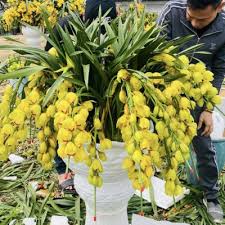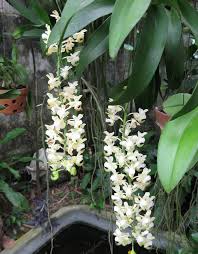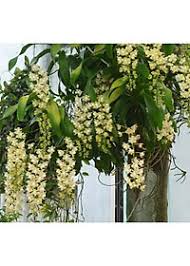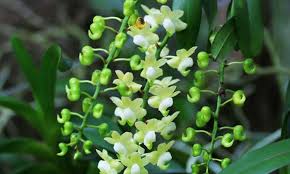
Orchids are among the most diverse and captivating flowering plants, cherished for their stunning beauty and unique characteristics. Among the myriad varieties of orchids, Sato Cymbidium orchids have gained significant popularity, especially in Vietnam and other parts of Asia. This article will explore the key differences and similarities between Sato Cymbidium orchids and other traditional orchid species, highlighting their unique attributes, care requirements, and cultural significance.
## 1. Introduction to Sato Cymbidium Orchids
Sato Cymbidium orchids are hybrids from the Cymbidium genus, which encompasses a wide variety of orchids known for their long-lasting blooms and robust structure. These orchids are recognized for their vibrant colors, large flowers, and ability to thrive in various environments, making them a popular choice among orchid enthusiasts.
### 1.1 Characteristics of Sato Cymbidium Orchids
– **Vibrant Colors:** Sato Cymbidium orchids come in a plethora of colors, including yellow, pink, white, green, and even rare shades like blue and purple. This diversity allows for stunning floral arrangements.
– **Size and Structure:** These orchids feature large flower spikes, with blooms that can measure up to 6 inches in diameter. Their sturdy structure enables them to hold their shape and beauty for extended periods.
– **Cultural Significance:** In Vietnamese culture, orchids symbolize elegance, beauty, and prosperity. Sato Cymbidium orchids are commonly used in floral arrangements for weddings, celebrations, and traditional ceremonies.
## 2. Overview of Traditional Orchid Species
While Sato Cymbidium orchids stand out for their unique attributes, various traditional orchid species also hold a special place in the hearts of enthusiasts and collectors. Some popular traditional orchid species include:
### 2.1 Phalaenopsis Orchids
Phalaenopsis orchids, also known as moth orchids, are one of the most widely recognized orchid species. They are characterized by their broad, flat petals and long-lasting blooms.
#### 2.1.1 Key Features
– **Colors:** Phalaenopsis orchids come in various colors, including white, pink, purple, and even striped varieties.
– **Size:** Typically, their blooms range from 3 to 5 inches in diameter.
– **Growing Conditions:** They thrive in bright, indirect light and prefer warm temperatures, making them suitable for indoor cultivation.
### 2.2 Dendrobium Orchids
Dendrobium orchids are another popular group of orchids known for their stunning flower spikes and varied shapes.
#### 2.2.1 Key Features
– **Colors:** Dendrobium orchids come in a wide range of colors, including yellow, white, pink, and purple.
– **Size:** The flowers vary significantly in size, ranging from 1 to 6 inches.
– **Growing Conditions:** Dendrobium orchids generally require more sunlight and thrive in cooler temperatures compared to Phalaenopsis orchids.
### 2.3 Cattleya Orchids
Cattleya orchids are often referred to as the “queen of orchids” due to their large and fragrant blooms.
#### 2.3.1 Key Features
– **Colors:** Cattleya orchids are available in vibrant colors, including deep reds, purples, and yellows.
– **Size:** Their flowers can be quite large, often measuring up to 8 inches in diameter.
– **Growing Conditions:** Cattleya orchids require bright light and well-draining potting media, making them suitable for outdoor cultivation in warmer climates.
### 2.4 Oncidium Orchids
Oncidium orchids, commonly known as dancing lady orchids, are recognized for their unique flower shapes and patterns.
#### 2.4.1 Key Features
– **Colors:** Oncidium orchids feature a variety of colors, often with intricate patterns and markings.
– **Size:** The flowers typically range from 1 to 3 inches in diameter.
– **Growing Conditions:** They prefer bright light and moderate humidity, thriving in both indoor and outdoor environments.
## 3. Comparing Sato Cymbidium Orchids with Traditional Orchid Species
While Sato Cymbidium orchids share similarities with traditional orchid species, they also possess distinct characteristics that set them apart. Below is a comparison of key aspects, including appearance, growth conditions, care requirements, and cultural significance.
### 3.1 Appearance and Flower Structure
– **Sato Cymbidium:** These orchids are known for their large, robust flowers with a wide variety of colors. The blooms are typically arranged on long spikes, creating an impressive visual display.
– **Phalaenopsis:** Known for their flat, wide petals, Phalaenopsis orchids often have a more delicate appearance. Their flowers typically grow in a more compact arrangement.
– **Dendrobium:** Dendrobium orchids feature elongated flower spikes with clusters of flowers. The blooms may vary significantly in size and shape, giving them a unique appearance.
– **Cattleya:** Cattleya orchids are characterized by their large, showy flowers that often have frilled edges. Their bold colors and fragrance make them stand out in any setting.
– **Oncidium:** Oncidium orchids exhibit a playful appearance, with flowers that resemble dancing figures. Their intricate patterns and shapes add to their charm.
### 3.2 Growth Conditions
– **Sato Cymbidium:** These orchids thrive in bright, indirect light and prefer a temperature range of 20°C to 30°C (68°F to 86°F) during the day, with cooler nighttime temperatures. They can tolerate higher humidity levels and require well-draining potting media.
– **Phalaenopsis:** These orchids prefer warm temperatures and bright, indirect light. They can tolerate lower humidity but thrive in environments with consistent moisture.
– **Dendrobium:** Dendrobium orchids require more sunlight and can tolerate a broader temperature range. They are adaptable to various growing conditions but prefer slightly cooler temperatures at night.
– **Cattleya:** Cattleya orchids thrive in bright light and warm temperatures. They require well-draining potting media and benefit from higher humidity levels.
– **Oncidium:** Oncidium orchids prefer bright light and moderate humidity. They thrive in warm temperatures and require well-draining media to prevent root rot.
### 3.3 Care Requirements
– **Sato Cymbidium:** Regular watering is essential, allowing the potting medium to dry slightly between waterings. Fertilization should be done every two to four weeks during the growing season.
– **Phalaenopsis:** They require consistent watering, allowing the potting medium to dry between waterings. Fertilization is recommended every two weeks during the growing season.
– **Dendrobium:** Dendrobium orchids should be watered thoroughly and allowed to dry between waterings. Fertilization is necessary during the growing season, with a focus on balanced nutrients.
– **Cattleya:** Cattleya orchids require frequent watering during the growing season and less during dormancy. They benefit from a high-nitrogen fertilizer during active growth.
– **Oncidium:** Oncidium orchids require regular watering and should be allowed to dry slightly between waterings. They benefit from regular fertilization to promote healthy growth.
### 3.4 Cultural Significance
– **Sato Cymbidium:** In Vietnamese culture, Sato Cymbidium orchids symbolize elegance and prosperity. They are often used in floral arrangements for celebrations and special occasions.
– **Phalaenopsis:** These orchids are widely regarded as symbols of beauty and love, often used in gifts and decor for weddings and romantic occasions.
– **Dendrobium:** Dendrobium orchids are associated with strength and resilience. They are often used in traditional ceremonies and are believed to bring good luck.
– **Cattleya:** Cattleya orchids symbolize luxury and beauty, making them popular choices for high-end floral arrangements and formal events.
– **Oncidium:** Oncidium orchids represent joy and warmth, making them popular for casual gifts and festive celebrations.
## 4. Conclusion
Sato Cymbidium orchids are a remarkable addition to the diverse world of orchids, standing out for their vibrant colors, large blooms, and cultural significance. While they share similarities with traditional orchid species such as Phalaenopsis, Dendrobium, Cattleya, and Oncidium, each type of orchid possesses unique characteristics and care requirements.
Understanding these differences can enhance one’s appreciation for these beautiful plants and provide insights into their cultivation and care. Whether you’re a seasoned orchid enthusiast or a beginner, exploring the world of Sato Cymbidium and other traditional orchids offers a rewarding experience filled with beauty, culture, and inspiration. By comparing these orchids, we can better understand their value and significance in horticulture and design, allowing us to enjoy their splendor for generations to come.
# Comparing Sato Cymbidium Orchids with Other Traditional Orchid Species: Part 2
In the previous section, we explored the unique characteristics of Sato Cymbidium orchids and provided an overview of traditional orchid species, including Phalaenopsis, Dendrobium, Cattleya, and Oncidium. In this part, we will delve deeper into specific comparisons between Sato Cymbidium orchids and these traditional varieties, discussing their cultivation techniques, pest management, and popular uses. Understanding these differences will not only enhance our appreciation of these orchids but also guide enthusiasts in making informed choices regarding their cultivation.
## 1. Cultivation Techniques
The cultivation of orchids varies significantly based on their species. Here we will examine the cultivation techniques for Sato Cymbidium orchids in comparison with traditional varieties.
### 1.1 Growing Medium
– **Sato Cymbidium:** These orchids thrive in well-draining potting media that typically includes a mix of bark, perlite, and sphagnum moss. This combination promotes aeration while retaining moisture, essential for healthy root development. Some growers prefer using a specialized Cymbidium potting mix that caters specifically to their needs.
– **Phalaenopsis:** Phalaenopsis orchids generally prefer a similar well-draining mix but often require more moisture retention. Growers frequently use a mix of fir bark, coconut coir, and perlite. This helps maintain humidity while allowing excess water to drain.
– **Dendrobium:** Dendrobium orchids also thrive in a well-draining medium but may benefit from a more fibrous mix that allows for better drainage and aeration. Many growers use a mix of bark, charcoal, and perlite.
– **Cattleya:** Cattleya orchids require a coarse mix to prevent root rot. Growers often use a combination of large bark chunks, sphagnum moss, and perlite. This medium allows for ample airflow around the roots, which is crucial for healthy growth.
– **Oncidium:** Oncidium orchids prefer a well-draining medium that retains some moisture. A mix of bark, charcoal, and perlite is commonly used, promoting good drainage while keeping roots hydrated.
### 1.2 Watering Needs
– **Sato Cymbidium:** Sato Cymbidium orchids require regular watering, but it is crucial to allow the potting medium to dry slightly between waterings. Overwatering can lead to root rot, which is a common issue among orchids. It is advisable to check the moisture level regularly and water accordingly, especially during the growing season.
– **Phalaenopsis:** Phalaenopsis orchids require a consistent watering schedule, typically every 1-2 weeks, allowing the potting medium to dry out slightly between waterings. They are sensitive to overwatering and can suffer if left in soggy conditions.
– **Dendrobium:** Dendrobium orchids need thorough watering during their active growth phase but should be allowed to dry out between waterings. During the dormancy period, watering should be reduced significantly to prevent root rot.
– **Cattleya:** Cattleya orchids require frequent watering during the growing season, usually every 5-7 days. During their dormancy period, watering should be reduced, allowing the medium to dry out completely between waterings.
– **Oncidium:** Oncidium orchids benefit from regular watering and should be kept evenly moist. They may require watering every 1-2 weeks, depending on environmental conditions.
### 1.3 Light Requirements
– **Sato Cymbidium:** Sato Cymbidium orchids thrive in bright, indirect light, with some direct sunlight exposure preferred. Growers often place them near east-facing windows or under grow lights to ensure they receive adequate light without scorching the leaves.
– **Phalaenopsis:** Phalaenopsis orchids require bright, indirect light, similar to Sato Cymbidium orchids. They can tolerate lower light levels but will produce fewer blooms if not provided with adequate light.
– **Dendrobium:** Dendrobium orchids generally prefer bright light, including some direct sunlight. However, the intensity should be monitored to prevent leaf burn, particularly during hotter months.
– **Cattleya:** Cattleya orchids thrive in bright, direct sunlight for several hours each day. Growers often position them in south or west-facing windows to meet their light requirements.
– **Oncidium:** Oncidium orchids prefer bright, filtered light, making them ideal candidates for east or west-facing windows. Too much direct sunlight can lead to leaf burn.
### 1.4 Fertilization
– **Sato Cymbidium:** Fertilization for Sato Cymbidium orchids should be done every two to four weeks during the growing season. A balanced fertilizer with equal parts nitrogen, phosphorus, and potassium is recommended to promote healthy growth and blooming.
– **Phalaenopsis:** Fertilization for Phalaenopsis orchids typically occurs every two weeks during the growing season. A balanced liquid fertilizer is ideal for providing the necessary nutrients for healthy growth.
– **Dendrobium:** Dendrobium orchids should be fertilized every two to four weeks during their active growth period, focusing on a balanced fertilizer to support blooming.
– **Cattleya:** Cattleya orchids benefit from higher nitrogen fertilizer during active growth and lower nitrogen during the blooming phase. Fertilizing every two weeks is recommended.
– **Oncidium:** Oncidium orchids should be fertilized every two weeks with a balanced fertilizer during the growing season to promote healthy growth and flowering.
## 2. Pest Management
Pest management is a critical aspect of orchid care. Each species can be susceptible to various pests, and understanding how to manage these issues is essential for successful cultivation.
### 2.1 Common Pests
– **Sato Cymbidium:** Common pests that may affect Sato Cymbidium orchids include aphids, mealybugs, and spider mites. Regularly inspecting plants for signs of infestation and treating them with insecticidal soap or neem oil can help manage these pests.
– **Phalaenopsis:** Phalaenopsis orchids are also susceptible to pests such as aphids, scale, and thrips. Quarantining new plants and regularly checking for infestations can help prevent pest problems.
– **Dendrobium:** Dendrobium orchids can be affected by mealybugs, aphids, and scale insects. Maintaining proper air circulation and humidity levels can reduce the likelihood of infestations.
– **Cattleya:** Cattleya orchids may attract pests such as aphids and spider mites. Keeping the growing environment clean and using insecticidal sprays as needed can help manage pest populations.
– **Oncidium:** Oncidium orchids can suffer from infestations of spider mites and aphids. Regularly inspecting and treating plants with insecticidal soap or neem oil can help keep pests at bay.
### 2.2 Disease Management
– **Sato Cymbidium:** Root rot is a common issue for Sato Cymbidium orchids, often caused by overwatering. To prevent this, it is crucial to use a well-draining potting medium and avoid letting the plant sit in water.
– **Phalaenopsis:** Phalaenopsis orchids can be prone to crown rot if water accumulates in the crown. Ensuring proper airflow and allowing the plant to dry out between waterings can help prevent this issue.
– **Dendrobium:** Dendrobium orchids can be susceptible to fungal diseases if humidity levels are too high. Providing adequate ventilation and monitoring moisture levels can help prevent these issues.
– **Cattleya:** Cattleya orchids are susceptible to fungal and bacterial infections, particularly in humid conditions. Using a clean potting medium and ensuring proper drainage can help minimize these risks.
– **Oncidium:** Oncidium orchids can develop root rot and other fungal infections due to excessive moisture. Providing good airflow and monitoring watering practices can help keep these issues at bay.
## 3. Popular Uses and Cultural Significance
Orchids have been celebrated in various cultures for their beauty, symbolism, and versatility. Below, we explore the popular uses of Sato Cymbidium orchids compared to traditional orchid species.
### 3.1 Decorative Uses
– **Sato Cymbidium:** Due to their large, vibrant blooms, Sato Cymbidium orchids are often used in floral arrangements for weddings, festivals, and special occasions. They symbolize elegance and prosperity, making them a favored choice for gift-giving.
– **Phalaenopsis:** Phalaenopsis orchids are popular for indoor decoration due to their long-lasting blooms and ease of care. They are often used in homes, offices, and as gifts.
– **Dendrobium:** Dendrobium orchids are frequently used in floral arrangements for their striking appearance and variety of colors. They are often seen in bouquets and centerpieces.
– **Cattleya:** Cattleya orchids are often used in formal arrangements and events due to their luxurious appearance and fragrance. They are popular choices for special occasions and celebrations.
– **Oncidium:** Oncidium orchids are favored for their playful shapes and colors, making them suitable for festive arrangements and casual gifts. They are often used in celebrations and parties.
### 3.2 Symbolism and Cultural Significance
– **Sato Cymbidium:** In Vietnamese culture, Sato Cymbidium orchids are associated with beauty, elegance, and prosperity. They are often used in ceremonies and celebrations, symbolizing good fortune and joy.
– **Phalaenopsis:** Phalaenopsis orchids symbolize love and beauty, making them popular for romantic occasions such as weddings and anniversaries.
– **Dendrobium:** Dendrobium orchids represent strength and resilience, often used in traditional ceremonies to convey wishes for good luck and success.
– **Cattleya:** Cattleya orchids symbolize luxury and beauty, making them popular in formal settings and as gifts for special occasions.
– **Oncidium
:** Oncidium orchids symbolize joy and friendship, often used in cheerful arrangements for gatherings and celebrations.
## 4. Conclusion
Sato Cymbidium orchids offer a unique and captivating option for orchid enthusiasts, with distinct cultivation techniques, pest management requirements, and cultural significance. While they share similarities with traditional orchid species, their unique traits and vibrant blooms set them apart. Understanding these differences not only enhances our appreciation of these exquisite plants but also aids in the successful cultivation and enjoyment of these orchids.
Incorporating Sato Cymbidium orchids into your collection can bring elegance and beauty to your space, while traditional varieties offer their own charm and cultural significance. By learning about the various species and their needs, enthusiasts can cultivate a thriving orchid garden that showcases the diversity and beauty of these remarkable plants. Whether you are a seasoned orchid grower or a novice, the journey of exploring and caring for these plants is rewarding, enriching your appreciation for nature’s wonders.


